Home > Case studies > How data-driven ergonomics can help objectify the “benefit/risk” ratio of using an exoskeleton
How data-driven ergonomics can help objectify the “benefit/risk” ratio of using an exoskeleton
Context and challenge
The purpose of this study is to objectively evaluate an exoskeleton efficiency in a context of facade renovation (involving stone cornice cutting). The principle adopted is based on a « before/after » comparison of the cutting activity, carried out with and without the help of an exoskeleton. While the objectivation is performed thanks to the CAPTIV solution and its sensors, the comparative analysis of similar sequences of work aims at determining the benefit/risk ratio.
Facade renovation is a physical activity subject to a significant MSD risk (Musculoskeletal Disorders). This activity is demanding as it generates constraints on all body segments and imposes risky postures to the workers.
A test was carried out on two subjects in order to obtain objective data with the following equipment: six Motion sensors (for angular and postural measurement), an ECG sensor (for heart rate measurement), a camcorder and the CAPTIV software.
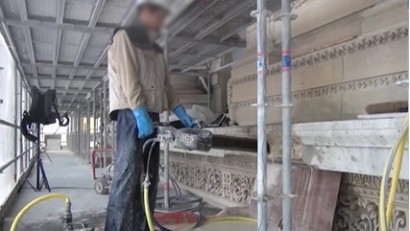
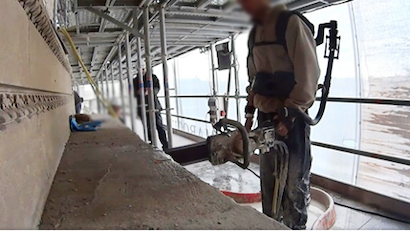
Methodology
The study took place at the Louvre Museum in Paris, France. In order to make relevant comparisons (same duration, same tasks), measurements were carried out in two one-hour recording sessions, one with and one without the exoskeleton. We assumed that both observed work sequences are representative of the tasks assigned to the worker.
Recordings of postural activity were produced for the back, shoulders and elbows. The indicators extracted for each joint angle (posture) are:
- The average angular data in relation to the “not recommended” o range zone threshold (in °),
- The average angular data in relation to the “hazardous” red zon e threshold (in °).
- Heart rate (HR) was continuously recorded during both work sequences.
Both results were combined with a Borg scale assessment, allowing us to collect the worker’s subjective perceived exertion.

The CAPTIV system was used for recording sensors’ data and synchronizing them with some video footage. The combination of both data streams allowed an in-depth analysis of the various biomechanical and physiological parameters.
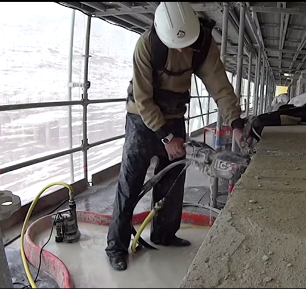
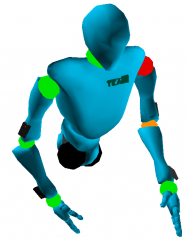
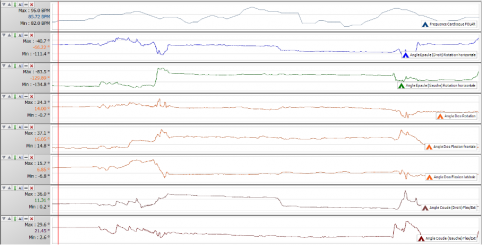
Results
Postural analysis
The figures below present a comparison of the back postural constraints (focusing on the rotational movement) with and without the use of the exoskeleton.

The worker’s back is more “aligned” and shows fewer hazardous rotational movements while wearing the device.
Cardiac analysis
Regarding cardiac effort, the results show a positive difference:


the cardiac stress is lower when the worker is actively wearing the exoskeleton.
These heart rate scores were also correlated to the Borg scale. According to the user, the activity of cornices cutting without exoskeleton is perceived as a “hard” (6 out of 10), while the implementation of the device changed this perception to a “moderate’ difficulty (3 out of 10).
Wearing the exoskeleton during tasks involving cornice cutting brings more benefits than risks. However, it is necessary to keep in mind the possible shift of the ergon omic risk to other joints.
Conclusion
By combining and synchronizing both objective data and video footage, the CAPTIV solution helped with the objective evaluation of an exoskeleton in a challenging work environment. The sensors’ robustness ensures the repeatability of testing several workers in naturalistic settings. Biomechanical and physiological data recorded are thus representative of real-life work situations. They allowed an objective and reliable assessment of the exoskeleton efficiency. This study defined a “Benefit/Risk” ratio of using an exoskeleton use in the specific context of fac ade renovation.
At the postural level, the use of the exoskeleton offers benefits for certain joints, especially in the back. However, a stress increase has been noticed on other joints, suggesting a possible shift of the risk while using this type of assistive device.
Opening
One should relativize the current results regarding the contribution of the use of the exoskeleton:
- The study was carried out on two workers,
- The angular differences in “not recommended” and “hazardous” areas are not significative enough to draw any definitive conclusion.
To validate the first results, it is necessary to carry out additional measurements on other users in order to:
- Be more representative,
- Integrate additional factors such as the morphologies and the expertise level of the user,
- Improve the integration of the user’s experience into the overall evaluation.
Several additional studies were carried out by TEA on behalf of the OPPBTP on the use of exoskeletons. It is a topic for which the need of objective measurements is of absolute necessity in order to assess the contribution of an exoskeleton, as simple visual observations from a professional ergonomist or the subjective feelings of the user are not sufficient for conducting a global evaluation.
